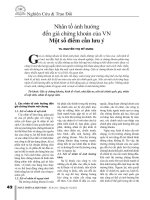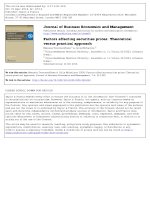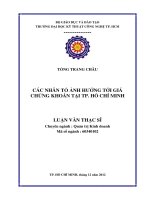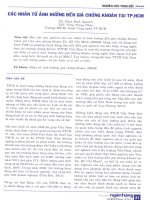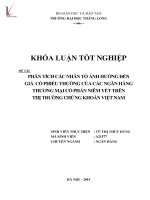Nhân tố ảnh hưởng đến giá chứng khoán
Bạn đang xem bản rút gọn của tài liệu. Xem và tải ngay bản đầy đủ của tài liệu tại đây (250.49 KB, 11 trang )
This article was downloaded by: [117.3.81.221]
On: 01 April 2014, At: 18:14
Publisher: Taylor & Francis
Informa Ltd Registered in England and Wales Registered Number: 1072954 Registered office: Mortimer
House, 37-41 Mortimer Street, London W1T 3JH, UK
Journal of Business Economics and Management
Publication details, including instructions for authors and subscription information:
/>Factors affecting securities prices: Theoretical
versus practical approach
Manuela Tvaronavičiene
a
& Julija Michailova
b
a
Vilnius Gediminas Technical University , Sauletekio al. 11, Vilnius, LT‐10223, Lithuania
E-mail:
b
Vilnius Gediminas Technical University , Sauletekio al. 11, Vilnius, LT‐10223, Lithuania
E-mail:
Published online: 14 Oct 2010.
To cite this article: Manuela Tvaronavičiene & Julija Michailova (2006) Factors affecting securities prices: Theoretical
versus practical approach, Journal of Business Economics and Management, 7:4, 213-222
To link to this article: />PLEASE SCROLL DOWN FOR ARTICLE
Taylor & Francis makes every effort to ensure the accuracy of all the information (the “Content”) contained
in the publications on our platform. However, Taylor & Francis, our agents, and our licensors make no
representations or warranties whatsoever as to the accuracy, completeness, or suitability for any purpose of
the Content. Any opinions and views expressed in this publication are the opinions and views of the authors,
and are not the views of or endorsed by Taylor & Francis. The accuracy of the Content should not be relied
upon and should be independently verified with primary sources of information. Taylor and Francis shall
not be liable for any losses, actions, claims, proceedings, demands, costs, expenses, damages, and other
liabilities whatsoever or howsoever caused arising directly or indirectly in connection with, in relation to or
arising out of the use of the Content.
This article may be used for research, teaching, and private study purposes. Any substantial or systematic
reproduction, redistribution, reselling, loan, sub-licensing, systematic supply, or distribution in any
form to anyone is expressly forbidden. Terms & Conditions of access and use can be found at http://
www.tandfonline.com/page/terms-and-conditions
213
Journal of Business Economics and Management ISSN 1611-1699
2006, Vol VII, No 4, 213–222
FACTORS AFFECTING SECURITIES PRICES: THEORETICAL VERSUS
PRACTICAL APPROACH
Manuela Tvaronavičienė
1
, Julija Michailova
2
Vilnius Gediminas Technical University, Saulėtekio al. 11, LT-10223 Vilnius, Lithuania
E-mail:
1
,
2
Received 5 May 2006; accepted 4 September 2006
Abstract. Securities market has been influenced by entirety of factors, which roughly could be divided into various groups.
In order to show complexity of phenomenon authors strive to overview theories of stock price behaviour. Taking into
account, that various authors present rather controversial empirical evidences of certain factors impact on stock’ prices,
authors of this paper try to test some relationships practically. Statistical analysis aiming to evaluate quantitatively the
dependence of stock index on some chosen statistically measurable factors is being performed. For the latter purpose
stock prices of Lithuanian companies and such macroeconomic variables as foreign direct investment, state budget revenue
and expenditure, gross domestic product, price index of consumer goods and services, money in a broad sense, average
profitability of governmental bonds and inflation have been employed.
Keywords: stock prices, securities price factors, macroeconomic variables.
1. Stock Prices Theories
Before we start the review of variables that have impact
on stock price changes let us overview main theo-
ries explaining stock price changes and formation.
1. The Efficient Market Hypothesis (EMH) is based
on assumption that there are large numbers of rational,
profit-seeking investors in the marketplace who re-
act quickly to the release of new information. As new
information about stocks appears, investors reassess
the intrinsic value of stock and adjust the price ac-
cordingly. Therefore, at any point in time a stock price
is an unbiased reflection of all available information
and represents the best estimate of the stock’s true
value (Cleary, 2001).
A distinction between three forms of EMH is being
made: a) the weak form, b) the semi-strong form, and
c) the strong form. However, it is the semi-strong form
of EMH that has formed the basis for most empirical
research (Russel, Torbey, 2002). The strong form of
market efficiency states that securities prices reflect
all available information, including private information.
However Russel and Torbey find that Seyhun in his
works, dated 1986 and 1998, provides sufficient evi-
dence that insiders profit from trading on information
not incorporated into prices (Russel, Torbey, 2002).
Hence the strong form of market efficiency does not
hold in the real world. The semi-strong form of EMH
asserts that securities prices reflect all publicly avail-
able information. There are no undervalued or over-
valued securities and thus, trading rules are incapable
of producing superior returns. When new information
is released, it is fully incorporated into the price rather
speedily. The availability of intraday data enabled tests
which offer evidence of public information impacting
stock prices within minutes (Russel, Torbey, 2002). The
weak form of the market efficiency hypothesis sug-
gests that past prices or returns reflect future prices
or returns (Russel, Torbey, 2002). However, the con-
cept of the weak form can be expanded to include
predicting future returns with the use of accounting for
macroeconomic variables (Russel, Torbey, 2002). The
disagreement on the degree of market efficiency, which
should be tested or included in empirical research,
continues through years.
Downloaded by [117.3.81.221] at 18:14 01 April 2014
Manuela Tvaronavičienė, Julija Michailova
214
2. The Random Walk Theory postulates that new in-
formation concerning stocks is disseminated randomly
over time. Therefore, price changes are random and
bear no relation to previous price changes (Cleary,
2001). So the theory tells us that if stock prices fol-
low a random walk, the market can be supposed to
be efficient in the sense that it discounts all available
information (Dockery et al., 2001). This hypothesis
has been widely tested in both developed and emerging
capital markets (Dockery et al., 2001). Overall, however,
the evidence has been somewhat mixed (Dockery et
al., 2001), i.e. several researchers find no evidence
of patterns in stock prices, while others support the
RWH (random walk theory).
3. The Rational Expectations Hypothesis is based
on the assumption that people are rational and make
intelligent economic decisions after weighing all avail-
able information and will use it intelligently in their
own self interest. Past mistakes can be avoided by
using the information to anticipate change (Cleary,
2001).
4. Behavioural Finance Theory is very different from
the random walk and the efficient market theories
(Investing internet site />igustockmarket.html). A theory stating that there are
important psychological and behavioural variables
involved in investing in the stock market that provide
opportunities for smart investors to profit (An investing
glossary on the web ).
For example, when a certain stock or sector becomes
“hot” and prices increase substantially without a change
in the company’s fundamentals, behavioural finance
theorists would attribute this to mass psychology (also
known as the “follow the herd instinct”). They therefore
might see the stock in the long term, knowing that
eventually the psychological bubble will burst and they
will profit (Investing internet site http://
www.investorguide.com; an investing glossary on the
web ). So the propo-
nents of this theory explain changes in stock market
prices by investors’ psychology, rather than statisti-
cal data.
Opponents of the three former theories state that there
is not the only one true value of a stock price, and that
investors do not always act rationally (see the Behav-
ioural Finance Theory). In times of uncertainty, other
factors such as mass investor psychology and the in-
fluence of program trading (Cleary, 2001) also affect
market prices. Mass investor psychology may cause
market participants to act irrationally. Therefore changes
in investors’ behaviour, are causing prices to tumble
(Cleary, 2001) or rocket up suddenly.
In conclusion, we see, that all these theories explain
changes in stock prices by changes in the expecta-
tions of market participants, which should be seen
as psychological or human factors affecting fluctua-
tions in securities market.
Stock prices reflect expectations of earnings, dividends,
and interest rates. As investors attempt to estimate
these future variables, their stock price decisions reflect
expectations for future economic activity, not current
activity (Reilly, Brown, 2003).
To test for rationality of market behaviour (i.e. ex-
amining the volatility of share prices relative to the
volatility of the fundamental variables that affect share
prices) volatility tests are used. The empirical evidence
provided by volatility tests, suggests that movements
in stock prices cannot be attributed merely to the
rational expectations of investors, but also involves an
irrational component (Russel, Torbey, 2002).
Shleifer and Summers (1990) state that there are two
types of investors in the market: 1) rational specula-
tors or arbitrageurs who trade on the basis of infor-
mation and 2) noise traders who trade on the basis
of imperfect information.
An observation of investors’ trading strategies (such
as trend chasing) in the market provides evidence for
decision making being guided by “noise” rather than
by the rational evaluation of information. Further support
is provided by professional financial analysts spend-
ing considerable resources in trying to predict both
the changes in fundamentals and also possible changes
in sentiment of other investors (Russel, Torbey, 2002).
Tracking these possible indicators of demand makes
no sense if prices responded only to fundamental news
and not to investor demand. They make perfect sense,
in contrast, in a world where investor’s sentiment moves
prices and so predicting changes in this sentiment pays
(Shleifer, Summers, 1990).
Black in his “Noise” (Black, 1986) also argues that
noise traders play a useful role in promoting trans-
actions (and thus, influencing prices) as informed trad-
ers like to trade with noise traders who provide li-
quidity. So long as risk is rewarded and there is limited
arbitrage, it is unlikely that market forces would elim-
inate noise traders and maintain efficient prices.
Many factors affect expectations and thus play a part
in determining securities prices. As it was mentioned
in our article, we will review only some of them which
are: monetary policy, external events, fiscal policy,
business cycles, dividends, inflation, and mass psy-
chology.
Downloaded by [117.3.81.221] at 18:14 01 April 2014
FACTORS AFFECTING SECURITIES PRICES: THEORETICAL VERSUS PRACTICAL APPROACH
215
2. Impact of Macroeconomic Factors
Many researchers have determined that macroeco-
nomic variables play an important role in determin-
ing stock prices and have found macroeconomic var-
iables to be important in regard to stock market. In
our empirical part we rely exclusively on chosen mac-
roeconomic factors.
Numerous studies have analyzed existence of the
relationship between money supply and stock price
changes. Special attention was paid to determination
of whether changes in money supply precede changes
in stock prices. Results of such researches tend to
change from time to time (Reilly, Brown, 2003). Various
studies supported the view that there is a strong leading
relationship between changes in money supply and
stock prices. Such results implied that changes in the
growth rate of the money supply could serve as a
leading indicator of stock price changes (Reilly, Brown,
2003).
Successive researchers have also found the relationship
between the money supply and stock prices, but these
researchers found that money supply growth chang-
es were not leading stock prices but constantly were
behind the stock returns by about one to three months.
Another group of studies analyzed relationship to
anticipated and unanticipated growth of the money
supply. In these researches weekly data on money
supply was used. The obtained results showed that
stock prices are influenced by money changes, but
they quickly adapt to unexpected changes in money
growth, hence for investors wishing to enjoy superi-
or returns it is a matter of high importance to prog-
nosticate unanticipated changes in money supply
growth. So there is a significant relationship between
the real quantity of money (defined as M2) and stock
prices: quantity of M2 demanded relative to income
is positively related to the deflated price of stocks three
quarters earlier and negatively related to the present
real stock price (Reilly, Brown, 2003).
Recent studies have found that stock returns are in-
fluenced by the monetary environment. The results
of these studies have indicated that the results of
precedent researches on relationship between stock
returns and some company variables or economic
variables can be strongly influenced by prevailing
monetary environment. A group of researchers showed
that the business conditions proxies such as the term
spread, dividend yield and default spread, have a dif-
ferent effect on stock returns depending on the pre-
vailing monetary policy, where monetary policy is
indicated by discount rate changes (Reilly, Brown,
2003). Their studies also show that the relationship
between stock price returns and both size and price-
to-book value ratio that was found in several studies
only holds during periods of easy monetary policy
(Reilly, Brown, 2003), i.e. declining interest rate en-
vironment.
The two most important tools of fiscal policy are levels
of government expenditures and taxation. An increase
in government spending has a stimulative effect on
the economy generally or specific segments of it
(Cleary, 2001), herewith and share prices; while a
cutback in spending has the opposite effect. Conversely,
tax increases dampen consumer spending and busi-
ness profitability, while tax cuts spur the economy and
boost profits and common share prices (Cleary, 2001).
Downs and Hendershot analyze impact of the Tax
Reform Act of 1986 on stock prices. This act cuts
the corporate tax rate, eliminates the investment tax
credit and lengthens tax depreciation on structures.
Authors find that, these changes should raise equity
values by 10 to 13 percent. The rise in stock prices
follows from the heavier taxation of new capital and
the resulting rise in returns on existing capital. (Downs
et al., 1987).
Darrat considers the possibility of changes in fiscal
policy (government debt) to exert important effect on
stock market and equity returns. In his survey Dar-
rat measures fiscal policy by the real market value
of privately held federal debt scaled by potential GNP.
His empirical results indicate that fiscal policy plays
an important role in determining stock prices in the
United States. Specifically the results show, that chang-
es in the stance of fiscal policy have (Darrat, 1990)
significant effect on changes in aggregate stock prices
during the estimation period (Darrat, 1990) (1961 to
1987). Author claims that the stock market can be
seen as an important channel “transmitting the influ-
ence of fiscal policy to the real side of the econo-
my” (Darrat, 1990).
It is clear that the general market, as reflected in the
major averages, impacts more than half of a stock’s
price, while earnings account for most of the rest
(Andrews, 2004). With this in mind, stock prices should
rise with falling interest rates because it becomes
cheaper for companies to finance projects and oper-
ations that are funded through borrowing. Lower
borrowing costs allow higher earnings which increase
the perceived value of a stock. Stocks, commodities
and existing bond prices tend to rise in a falling in-
terest rate environment (Andrews, 2004). Relation-
ship between interest rates and bond prices is inverse,
i.e., an increase in interest rates will cause a decline
Downloaded by [117.3.81.221] at 18:14 01 April 2014
Manuela Tvaronavičienė, Julija Michailova
216
in bond prices and a decline in interest rates will raise
bond prices.
Many authors accentuate the depressing effect of
inflation on stock prices (Cleary, 2001), as inflation-
ary price pressures create widespread uncertainty and
lack of confidence in the future. These factors tend
to lower corporate profits (Cleary, 2001). Consequently
lower corporate profitability as a result of inflation
makes common shares less attractive to investors
(Cleary, 2001). As in the case of stocks, inflation
causes bond markets to perform poorly. Inflation
causes growth of interest rates, and hence bond prices
fall. Both stock and bond prices fall in an inflation-
ary environment, mostly because of the anticipated
rise in interest rates (Andrews, 2004).
However the relationship between inflation, interest
rates and stock prices is not direct and consistent. The
reason is that the cash flows from stocks can change
along with inflation and interest rates, and we can-
not be certain whether this change in cash flows will
augment the change in interest rates (Reilly, Brown,
2003). For instance, unexpected inflation can have as
well as negative or positive effects on stock returns;
this depends on the source of inflation. Here we do
not discuss macroeconomic shocks, which affect
securities prices crucially (Ewing et al., 2003).
Notably, the actual relationship between inflation, in-
terest rates, and stock prices is an empirical ques-
tion and the effect varies over time. Therefore, al-
though there has generally been a significant negative
relationship between inflation, interest rates, and the
returns on stock, this is not always true. In addition,
even when it is true for the most of the market, cer-
tain industries may have earnings, cash flows, and
dividends that react positively to inflation and inter-
est rate changes. In such an instance, their stock prices
would be positively correlated with inflation and in-
terest rates (Reilly, Brown, 2003).
The health of the economy has a fundamental influ-
ence on share prices because it is ultimately respon-
sible for driving company profits. Broadly speaking,
if the economy is growing, company profits improve
and shares will become more highly valued. If the
economy is weakening, company profits will fall and
share prices will go down (London Stock Exchange,
2005).
Nevertheless, as it was mentioned in the very begin-
ning, share prices can rise and fall for a variety of
technical reasons that may have nothing to do with
the actual outlook for an individual company or the
outlook for the market (London Stock Exchange, 2005).
Share prices can also be affected by investors who
use technical analysis to drive their investment tech-
niques (London Stock Exchange, 2005) as well as by
“marketmakers”. Technical indicators are rather pop-
ular because they are immediate, they are easily
understood, and they are reassuring (Thomsett, 1998).
3. The Main Macroeconomic Variables
Affecting Stock Prices of Lithuanian
Companies
In the previous parts the article overviews the main
factors that have impact on the performance of stock
market and stock prices of particular companies. After
examination of theoretical problem the empirical anal-
ysis of Lithuanian stock market is executed. This
analysis is concentrated on the estimation of coun-
try’s economical development impact on stock pric-
es of Lithuanian companies. The research tests for
relationship between stock prices and economic ac-
tivity, measured on the basis of following macroeco-
nomic variables reflecting economic situation of Lithua-
nia:
• Foreign direct investment (FDI);
• State budget revenue;
• State budget expenditure;
• Gross domestic product (at current prices)
(GDP);
• Price index of consumer goods and services
(compared to previous period) (CPI);
• Money (M2);
• Average profitability of governmental bonds;
• Inflation.
By the set of factors authors seek to reflect mone-
tary policy (M2), fiscal policy (state budget revenue
and expenditure), alternative risk-free investment
measures (governmental bonds), availability of funds
for stock-investment (GDP, FDI), rate of change in
purchasing power (inflation, CPI).
OMX Vilnius Stock Index (OMXV) – a capitaliza-
tion weighted chain-linked total-return index, calcu-
lated on a continuous basis using the most recent prices
of all shares that are listed on the Vilnius Stock Ex-
change – is being used (Vilnius Stock Exchange, http:/
/www.lt.omxgroup.com). The index base value was
set at 100.00 points on January 1, 2000 (Vilnius Stock
Exchange, ). The index
is calculated using prices in trading currency (LTL).
Officially, till 27 September 2004 Vilnius Stock Ex-
change used another aggregated index for all listed-
companies LITIN-G. Our analysis is based on quar-
terly data for the period of 2000 IQ to 2005 IIIQ,
calculated for the newly introduced index OMXV.
Downloaded by [117.3.81.221] at 18:14 01 April 2014
FACTORS AFFECTING SECURITIES PRICES: THEORETICAL VERSUS PRACTICAL APPROACH
217
In order to determine the relationship between in-
dex OMXV and macroeconomic factors the corre-
lation-regression analysis was executed. For this
purpose MS Excel program is used. Data used for
the analysis is obtained from following sources:
OMXV values are taken from Vilnius Stock Exchange
web-page (Vilnius Stock Exchange), respectively
FDI, state budget revenue and expenditure, GDP, CPI,
M2 and inflation rate are obtained from monthly
bulletin of Department of Statistics (Lithuanian
Department of Statistics, 2006), average profitabil-
ity of governmental bonds from Bank of Lithuania
web-page (The Bank of Lithuania) and quarterly
bulletins (The Bank of Lithuania, Quarterly Bulle-
tin). All data are presented in Table 1. Graphical
reflection of quarterly data chosen for the analysis
is presented in Appendix 1.
Table 1. Data for the empirical research of stock prices dependence on macroeconomic variables
First of all, the existence of stochastic relationship
between OMXV and variables chosen for the analy-
sis must be estimated. For this purpose correlation
coefficients between OMXV and each of the macr-
oeconomic variables are calculated. To evaluate their
significance the values of Student criterion (t) are
calculated and compared with critical value of Stu-
dent criterion (table-value) (t
T
): if observed value is
higher or equal to t-critical value (t > t
T
) then the re-
lationship is significant and stochastic relationship exists.
If t < t
T
– conclusion about existence of the relationship
can not be made and analysis should be continued.
Results of executed correlation test are given in Ta-
ble 2 and Table 3.
Now we are looking for the form and analytical ex-
pression of stochastic relationship. This is executed
1
Data from 2000 IQ till 2002 IQ are calculated by the authors of the survey, on the basis of data from the Bank of Lithuania internet page
(The Bank of Lithuania, 2002 IIQ – 2005 IIIQ data is taken from quarterly reports of Bank
of Lithuania (The Bank of Lithuania, Quarterly Bulletin).
Y X
1
X
2
X
3
X
4
X
5
X
6
X
7
X
8
Quarters
OMXV
FDI,
beginning
of period,
Lt mill.
State
budget
revenue,
Lt mill.
State
budget
expendi-
ture, Lt
mill.
GDP at
current
prices, Lt
mill.
CPI as
compared
to
previous
period
Money
M2,
Lt mill.
Average
profitabilit
y of
governmen
tal bonds
1
,
%
Inflation
%
2000 IQ 102.34 8252.1 1312.6 1530.2 10404.7 101.6 8885.00 12.41 1.3
2000 IIQ 92.66 8372.6 1472.2 1605.1 11622.2 99.9 9334.70 12.44 0.4
2000 IIIQ 92.26 8729.0 1440.0 1559.8 11899.2 99.6 9854.30 10.99 –0.1
2000 IVQ 92.70 9054.0 1556.5 1147.1 11922.4 100.2 10455.40 9.01 0.7
2001 IQ 87.39 9337.3 1633.3 1546.1 10888.7 100.4 10611.90 8.93 0.5
2001 IIQ 82.13 9549.2 1496.7 1901.8 12238.2 101.1 10937.60 7.41 1.3
2001 IIIQ 68.81 10167.3 1536.5 1581.9 12691.3 100.1 11712.10 7.00 –0.4
2001 IVQ 75.56 10458.5 1678.2 1945.1 12744.7 100.5 12690.60 6.07 0.6
2002 IQ 89.78 10661.9 2096.8 2188.0 11318.9 100.8 12826.50 5.56 0.1
2002 IIQ 83.52 10741.8 2340.8 2422.3 13084.7 99.1 13010.90 5.41 –0.8
2002 IIIQ 87.21 12048.5 2121.7 2404.1 13810.4 98.8 13968.80 4.99 –1.4
2002 IVQ 84.78 12586.7 2341.0 2997.4 13734.5 100.3 14834.60 4.81 1.1
2003 IQ 96.70 13183.8 2165.4 2264.7 12442.5 100.1 14829.30 4.86 0.0
2003 IIQ 134.97 13783.7 2229.4 2881.6 14120.6 100.0 15581.10 4.34 –0.1
2003 IIIQ 176.21 14046.4 2513.0 2539.1 14956.4 98.6 16335.20 4.26 –1.8
2003 IVQ 174.48 13262.9 2716.8 3130.0 15252.4 100.0 17536.80 4.08 0.6
2004 IQ 217.8 13699.4 2332.4 2431.3 13366.6 100.2 17949.00 3.88 0.3
2004 IIQ 206.31 14363.9 2679.5 3211.7 15346.2 101.7 18848.10 3.66 2.0
2004 IIIQ 223.71 14977.7 3261.2 2992.4 16660.0 100.5 19601.20 3.78 0.2
2004 IVQ 293.44 15365.7 3520.9 4017.1 17067.3 100.7 21765.50 3.43 0.4
2005 IQ 346.39 16192.6 3214.3 3279.0 14734.5 100.2 23107.70 3.11 0.6
2005 IIQ 413.37 17532.7 3593.7 3785.2 17638.6 101.0 24561.20 3.20 0.8
2005 IIIQ 523.04 17538.6 3752.1 3028.1 19070.1 100.4 25719.50 3.50 0.8
Downloaded by [117.3.81.221] at 18:14 01 April 2014
Manuela Tvaronavičienė, Julija Michailova
218
by search for regression line Y
xi
= a
0
+ a
1 *
X
i
, where
i = 1, 2, 3, 4, 5, 6, 7, 8. Economical meaning of coef-
ficient a
1
of the regression line is such – with the
change of the macroeconomic variable by one meas-
urement unit, value of OMXV changes by a
1
value.
By means of MS Excel functions INTERCEPT (a
0
)
and SLOPE (a
1
) coefficients of single linear regres-
sion lines were obtained (Table 4).
On the basis of these regression coefficients regres-
sion lines were constructed:
OMXV^
x1
= –276.12366 + 0.03591 · X
1
;
OMXV^
x2
= –157.65136 + 0.14096 · X
2
;
OMXV^
x3
= –101.05922 + 0.10942 · X
3
;
OMXV^
x4
= –463.94751+ 0.04579 · X
4
;
OMXV^
x5
= –3134.50811 + 32.93401 · X
5
;
OMXV^
x6
= –180.02087 + 0.02250 · X
6
.
OMXV^
x7
= 306.22223 – 23.31766 · X
7
;
OMXV^
x8
= 157.70614 + 30.74911 · X
8
.
To evaluate the adequacy of these analytical expres-
sions to a real situation the F-observed (F) statistic
must be calculated and compared to the F-critical value
(table-value or F
T
). If F is higher than F
T
then the
regression line adequately reflects the analysed data.
The F-critical value and the F-observed values are
represented in the Table 5.
Compared to F-critical, observed Fisher coefficients
for regression line OMXV^
x1
, OMXV^
x2
, OMXV^
x4
,
OMXV^
x6
are substantially greater than critical val-
ue 2.07. Therefore, these regression equations are use-
fu in predicting the value of OMXV index and can
be used for planning. Equations which are adequate
to real situation are presented in the following graphs
(Fig 1–4). Graphs are obtained by means of the pro-
gram Analyse-it for Microsoft Excel.
Multiple regression analysis
In the real world all these factors have an aggregate
effect on stock prices, which can be estimated by
Table 2. Correlation coefficients between OMXV and macroeconomic variables. Values of t-observed and t-critical
Table 3. Comparison of calculated and critical value of Student criterion
X
1
X
2
X
3
X
4
X
5
X
6
X
7
X
8
r (correlation
coefficient) 0.85203 0.87113 0.69919 0.85261 0.20555 0.91787 –0.55534 0.21478
t (statistics) 7.45841 8.12944 4.48159 7.47707 0.96251 10.59812 3.06013 1.00777
t
T
(table-value) 2.07961 2.07961 2.07961 2.07961 2.07961 2.07961 2.07961 2.07961
t(Y/X
1
)= 7,4584 > t
T
= 2.07961 Stochastic relationship exists
t(Y/X
2
)= 8,1294 > t
T
= 2.07961 Stochastic relationship exists
t(Y/X
3
)= 4,4816 > t
T
= 2.07961 Stochastic relationship exists
t(Y/X
4
)= 7,4771 > t
T
= 2.07961 Stochastic relationship exists
t(Y/X
5
)= 0,9625 > t
T
= 2.07961 Stochastic relationship exists
t(Y/X
6
)= 10,5981 > t
T
= 2.07961 Stochastic relationship exists
t(Y/X
7
)= 3,0601 > t
T
= 2.07961 Stochastic relationship exists
t(Y/X
8
)= 1,0078 < t
T
= 2.07961 No conclusion on existence of stochastic relationship
Table 4. Single linear regression coefficients
X
1
X
2
X
3
X
4
X
5
X
6
X
7
X
8
a
0
–276.12366 –157.65136 –101.05922 –463.94751 –3134.50811 –180.02087
306.22223 157.70614
a
1
0.03591 0.14096 0.10942 0.04579 32.93401 0.02250 –23.31766 30.74911
Downloaded by [117.3.81.221] at 18:14 01 April 2014
FACTORS AFFECTING SECURITIES PRICES: THEORETICAL VERSUS PRACTICAL APPROACH
219
multiple linear regression analysis. This analysis is a
helpful tool in determination of the existence and
analytical expression of the aggregate relationship
between OMXV index and all, chosen for the analy-
sis, factors. We generated the regression line:
OMXV^
x1, x2, x3, x4, x5, x6, x7, x8
= a
0
+ a
1
⋅ X
1
+ a
2
⋅ X
2
+ a
3
⋅
X
3
+ a
4
⋅ X
4
+ a
5
⋅ X
5
+ a
6
⋅ X
6
+ a
7
⋅ X
7
+ a
8
⋅ X
8
.
After execution of calculations by means of MS Excel
program’s LINEST function the multiple regression
line coefficients were obtained (Table 6).
Based on the obtained values of coefficients the re-
gression line is constructed:
OMXV^
x1, x2, x3, x4, x5, x6, x7, x8
= – 1366.38241 – 0.00844⋅ X
1
–
0.00656⋅ X
2
– 0.04265⋅ X
3
+ 0.00450 ⋅ X
4
+ 9.22141 ⋅ X
5
+
0.04217 ⋅ X
6
+ 20.62749 ⋅ X
7
– 9.05071 ⋅ X
8
.
Table 5. Fisher coefficients of single linear regression analysis
Fig 4. Dependence of OMXV index on M2 (mill. Lt)
Fig 2. Dependence of OMXV index on state budget revenue
(mill. Lt)
Fig 1. Dependence of OMXV index on FDI (mill. Lt)
Fig 3. Dependence of OMXV index on GDP (mill. Lt)
X
1
X
2
X
3
X
4
X
5
X
6
X
7
X
8
F 3.33165 3.786426 1.78629 3.34377 0.95332 5.79652 1.32019 0.9572
F
T
2.07331 2.07331 2.07331 2.07331 2.07331 2.07331 2.07331 2.07331
Downloaded by [117.3.81.221] at 18:14 01 April 2014
Manuela Tvaronavičienė, Julija Michailova
220
To estimate adequacy of the obtained analytical ex-
pression to the real situation we must calculate and
compare Fisher criterion (F) to critical value of Fisher
criterion (F
T
). If our calculated F > F
T
the conclusion,
that regression line describes the situation adequate-
ly, can be made. Obtained results (Table 6) obvious-
ly point to the adequateness of the found regression
line to the real situation. Moreover determination co-
efficient R
2
shows that common regression line ex-
plains about 98 % of distribution of OMXV index. This
means that index OMXV dependence on chosen for
the analysis macroeconomic variables is about 98 %.
Significance of determination coefficient is proven by
calculated value of Student’s criterion (27.3), which
is higher than t-critical value (2.09) (see Table 7).
The obtained results of the survey let us make a
conclusion, that the performance of stock market and
stock price changes, is affected by the overall per-
4. Conclusions
We agree that any continuously changing factors are
at work to change securities prices in general and prices
of various types and groups of securities in particu-
lar (Cleary, 2001). Nevertheless, the economy and the
stock market have a strong, consistent relationship
(Reilly, Brown, 2003).
For many years economists, statisticians, and teach-
ers of finance have been interested in developing and
testing models (Fama, 1965) which would explain
changes in stock prices. The relationship of stock
returns and fundamental variables has been extensively
studied through decades. There is a large amount of
evidence that short and long-horizon stock price chang-
es, and so returns, are dependent on fundamental
variables such as dividend yields. Other studies have
found that stock returns are predictable from a whole
set of economical variables such as monetary and fiscal
policies, interest rates, inflation, the economic and
external events, business cycles, technical factors, etc.
Empirical analysis of Lithuanian stock market, con-
centrated on the estimation of country’s economical
development impact on stock prices of Lithuanian
companies proved the existence of relationship be-
tween stock prices, represented by OMX Vilnius Stock
Index (OMXV), and economic activity, measured by
following macroeconomic variables: foreign direct
investment, state budget revenue, state budget expend-
iture, gross domestic product, price index of consumer
goods and services, money supply, average profita-
bility of governmental bonds and inflation. Evaluation
of reliability of the obtained results showed that 4 out
of 8 obtained single linear regression lines are ade-
quate to real situation; multiple regression line described
98 % of OMXV index distribution.
References
An investing glossary on the web http://
www.investorwords.com
Andrews, J. A. (2004) Forces that Move Stock Prices. Ar-
ticles Database />Black, F. (1986) Noise. Journal of Finance, Vol 41, p. 529–
543.
Table 6. Coefficients of multiple linear regression
F 40.155
F
T
2.203
R
2
0.975
t 27.275
t
T
2.093
Table 7. Statistics of multiple linear regression analysis
formance of the economy. Aggregate impact of several
macroeconomic factors, chosen for the analysis, ex-
plains more than 97 % of changes in stock prices.
By being evaluated all together GDP, CPI, M2, av-
erage profitability of governmental bonds have posi-
tive impact on stock prices; whereas FDI, state budget
revenue and expenditure as well as inflation have
negative impact.
Hence, stock market reacts to various leading indi-
cator series, the most important of which are mon-
ey supply, inflation rate, GDP, CPI, FDI, governmental
bonds’ profitability, etc. As these series tend to “lead
the economy”, when investors adjust stock prices to
reflect expectations for these leading economic se-
ries, this makes stock prices a leading series as well.
a
0
a
1
a
2
a
3
a
4
a
5
a
6
a
7
a
8
–1366,38241
–0,00844
–
0,00656
–
0,04265 0,00450 9,22141 0,04217 20,62749
–
9,05071
Downloaded by [117.3.81.221] at 18:14 01 April 2014
FACTORS AFFECTING SECURITIES PRICES: THEORETICAL VERSUS PRACTICAL APPROACH
221
Cleary, S. (2001) Canadian Securities Exam: Fast-Track Study
Guide, Ontario: John Wiley and Sons Canada. 320 p.
Darrat, A. F. (1990) The Impact of Federal Debt upon Stock
Prices in the United States. Journal of Post Keynesian
Economics, Vol 12, Issue 3, p. 375–389.
Dockery, E.; Vergary, D.; Vergary, F. (2001) Explaining the
Behaviour of Stock Prices in an Emerging Market: An
Empirical Analysis of the Greek Stock Market. Mana-
gerial Finance, Vol 27, No 1, p. 82–98.
Downs, Th.; Hendershott, P. H. (1987) Tax Policy and Stock
Prices. National Tax Journal, Vol 40, Issue 2, p. 183–190.
Ewing, B. T.; Forbes, S. M.; Payne, J. E. (2003) The Effects
of Macroeconomic Shocks on Sector Specified Returns.
Applied Economics, Vol 35, p. 201–207.
Fama, E. F. (1965) Random Walks in Stock Market Prices.
Financial Analysts Journal, Vol, 21, No 5, p. 55–59.
Investing internet site />igustockmarket.html
London Stock Exchange. What Factors Influence a Share
Price? 2005, London Stock Exchange web-page, http://
www.londonstockexchange.com/en-gb/pricesnews/in-
vestorcentre/knowledge/investmentfactsheets/influ-
enceshareprice.htm
Reilly, F. K.; Brown, K. C. (2003) Investment Analysis and
Portfolio Management. Thomson South-Western, 1248 p.
Russel, P. S.; Torbey, V. M. (2002) The Efficient Market Hy-
pothesis on Trial: A Survey. B-Quest: Journal of ap-
plied Topics in Business and Economics of University
of West Georgia, %7Ebquest/
2002/market.htm
Shleifer, A. L.; Summers, H. (1990) The Noise Trader Ap-
proach to Finance. Journal of Economic Perspectives,
Vol 4, p. 19–33.
Statistics Department of Lithuania. Economic and Social
Development in Lithuania (monthly report). Vilnius, 2006,
Vol. 1, 176 p.
The Bank of Lithuania. Quarterly Bulletin. Vilnius: Lietu-
vos Bankas, issues from 2002/3Q to 2005/3Q.
Thomsett, A. C. (1998) Mastering Fundamental Analysis.
Dearborn Financial Publishing. 256 p.
The Bank of Lithuania. Statistical Data on Lithuanian Econ-
omy, />Vilnius Stock Exchange. Calculation of OMX Vilnius.
Vilnius Stock Exchange web-page, http://
www.lt.omxgroup.com/
Vilnius Stock Exchange. Statistical data on OMXV index
history. VSE internet page />?pg=charts
Downloaded by [117.3.81.221] at 18:14 01 April 2014
Manuela Tvaronavičienė, Julija Michailova
222
Appendix 1. Dynamics of the analysed data through the period of research (2000 IQ to 2005 IIIQ)
Downloaded by [117.3.81.221] at 18:14 01 April 2014



